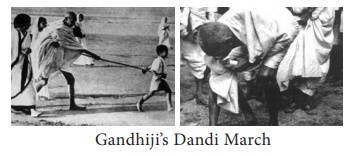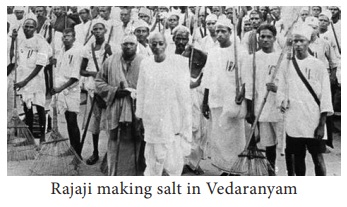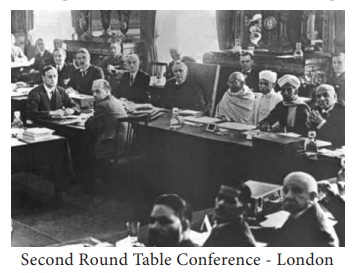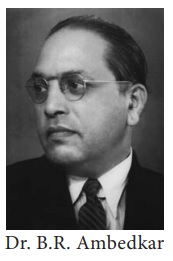India Nationalism: Gandhian Phase - The Struggle for Poorna Swaraj and Launch of Civil Disobedience Movement | 10th Social Science : History : Chapter 8 : Nationalism: Gandhian Phase
Chapter: 10th Social Science : History : Chapter 8 : Nationalism: Gandhian Phase
The Struggle for Poorna Swaraj and Launch of Civil Disobedience Movement
The Struggle for Poorna Swaraj and
Launch of Civil Disobedience Movement
Meanwhile
some congressmen were not satisfied with dominion status and wanted to demand
complete independence. In the Congress session held in Lahore in December 1929
with Jawaharlal Nehru as the President, Poorna Swaraj was declared as the goal.
It was also decided to boycott the Round Table Conference and launch a Civil
Disobedience Movement. 26 January 1930 was declared as Independence Day and a
pledge was taken all over the country to attain Poorna Swaraj non-violently
through civil disobedience including non-payment of taxes. The Indian National
Congress authorised Gandhi to launch the movement.
(a) Salt Satyagraha Movement
A charter
of demands presented to the Viceroy Lord Irwin with an ultimatum to comply by
31 January 1930 included:
ŌĆó Reduction
of expenditure on army and civil services by 50%
ŌĆó Introduction
of total prohibition of liquor
ŌĆó Release
of all political prisoners
ŌĆó Reduction
of land revenue by 50%
ŌĆó Abolition
of salt tax.

When the
Viceroy did not respond to the charter of demands, Gandhi launched the Civil
Disobedience Movement. The inclusion of abolition of salt tax was a brilliant
tactical decision. At the break of dawn on 12 March 1930 Gandhi set out from
Sabarmati Ashram with 78 of its inmates. The procession became larger and
larger when hundreds joined them along the march. At the age of 61 Gandhi
covered a distance of 241 miles in 24 days to reach Dandi at sunset on 5 April
1930. The next morning, he took a lump of salt breaking the salt law.
Salt Satyagraha in Provinces
In Tamil
Nadu, C. Rajaji led a similar salt march from Tiruchirappalli to Vedaranyam.
Salt marches took place in Kerala, Andhra and Bengal. In the North West
Frontier Province Khan Abdul Ghaffar Khan led the movement. He organized the
Khudai Khidmatgar, also known as the Red Shirts.

The British enacted the first forest act in 1865. This act
restricted the access of the forest dwellers to the forest areas to collect
firewood, cattle fodder and other minor forest produce such as honey, seeds,
nuts, medicinal herbs. The Indian Forest Act of 1878 claimed that original
ownership of forests was with the state. Waste lands and fallow lands were
included as forest. Shifting cultivation practiced by, the tribal people, was
prohibited. Alienation of forests from local control was stiffly resisted by
the aggrieved adivasis (tribals) and the nationalists.
The most striking evidence of continuing struggles of the tribal
groups was the one waged by Alluri Sitarama Raju in Rampa. RajuŌĆÖs efforts at
fighting corrupt officials to protect the interests of Rampa tribals prompted
the British to target his life. A special Malabar Police team was sent to quell
the uprisings (1922- 24) of Rampa Adivasis. Alluri Sitarama Raju attained
martyrdom for the cause of forest dwellers.
Gandhi
was arrested at midnight and sent to Yeravada Jail. Jawaharlal Nehru, Khan
Abdul Ghaffar Khan and other leaders were swiftly arrested. Soon other forms of
protests such as boycott of foreign cloth, picketing of liquor shops,
non-payment of taxes, breaking of forest laws etc. were adopted. Women,
peasants, tribals, students, even children and all sections participated in the
nation-wide struggle. It was the biggest mass movement India had ever
witnessed.
(b) Round Table Conferences
In the
midst of the movement the First Round Table Conference was held at London in
November 1930. Ramsay Macdonald, the British Prime Minister, proposed a federal
government with provincial autonomy. The Congress did not attend it as its
leaders were in jail. The Conference closed without any decision on the
question.
(c) Gandhi-Irwin Pact
Lord
Irwin held talks with Gandhi which resulted in the GandhiŌĆōIrwin Pact on 5 March
1931. The British agreed to the demand of immediate release of all political
prisoners not involved in violence, return of confiscated land and lenient
treatment of government employees who had resigned. It also permitted the
people of coastal villages to make salt for consumption and non-violent
picketing. The Congress agreed to suspend the Civil Disobedience Movement and
attend the conference. Gandhi attended the Second Round Table Conference which
began on 7 September 1931. Gandhi refused to accept separate electorates for
minorities. As a result, the second conference ended without any result.

(d) Renewal of Civil Disobedience Movement.
On
returning to India, Gandhi revived the Civil Disobedience Movement. This time
the government was prepared to meet the resistance. Martial law was enforced
and Gandhi was arrested on 4 January 1932. Soon all the Congress leaders were
arrested too. Protests and picketing by the people were suppressed with force.

In the
meantime, the Third Round Table Conference was held from 17 November to 24
December 1932. The Congress did not participate in the conference as it had
revived the Civil Disobedience Movement.
(e) Communal Award and Poona Pact
On 16
August 1932, Ramsay MacDonald, announced the Communal Award. It provided
separate electorates to the minorities, viz. Muslims, Sikhs, Indian Christians,
Anglo-Indians and women and the ŌĆ£depressed classesŌĆØ. B.R. Ambedkar, the leader
of the depressed classes, strongly argued for the separate electorate, as it,
according to him, would give them political representation and power. On 20
September 1932, Gandhi went on a fast unto death against the separate
electorates for the depressed classes. Madan Mohan Malaviya, Rajendra Prasad
and others held talks with Ambedkar and M.C. Rajah the leaders of the depressed
classes. After intense negotiations an agreement was arrived between Gandhi and
Ambedkar. Known as the Poona Pact, its main terms were:
ŌĆó The
principle of separate electorates was abandoned. Instead, the principle of
joint electorate was accepted with reservation of seats for the depressed
classes.
ŌĆó Reserved
seats for the depressed classes were increased from 71 to 148. In the Central
Legislature 18 percent of the seats were reserved.
(f) Campaign Against Untouchability
Gandhi devoted the next few years towards
abolition of untouchability. His engagement with Dr. B.R. Ambedkar made a big
impact on his ideas about the caste system. He shifted his base to the
Satyagraha Ashram at Wardha. He undertook an all-India tour called the Harijan
Tour. He started the Harijan Sevak Sangh to work for the removal of
discriminations. He worked to promote education, cleanliness and hygiene and
giving up of liquor among the depressed class. An important part of the
campaign was the Temple Entry Movement. 8 January 1933 was observed as ŌĆśTemple
Entry DayŌĆÖ.

Related Topics